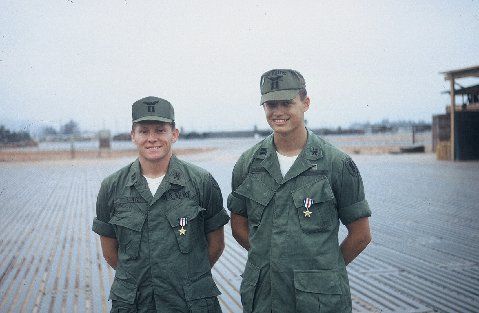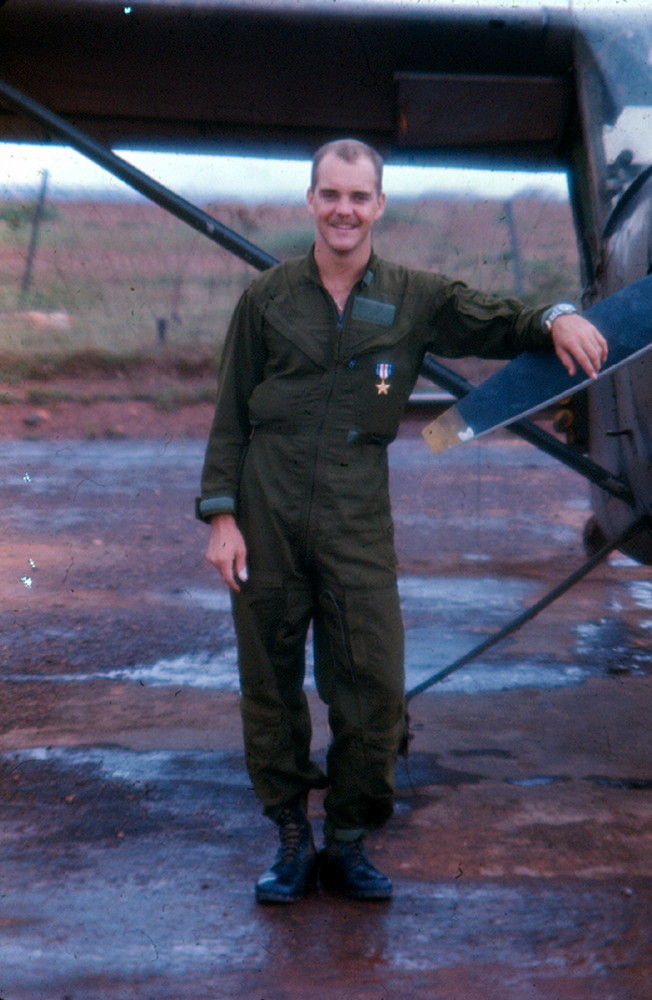History of the 220th Aviation Company—1968
Overview,
by Gene Wilson
Updated 13 September 2015
This year began with a new intensity, particularly in the DMZ area, with the known and suspected movement of VC and North Vietnamese Regular units into the entire I Corps area:
On 10 January and 15 January, respectively, the efforts of the 3rd Platoon and the 2nd Platoon of the 220th, in support of operations of Headquarters I Corps in the Da Nang sector of responsibility and the 1st ARVN Division in northern I Corps for the period August 1966 through December 1967, was recognized by the following letters of appreciation from their respective Advisory Groups.
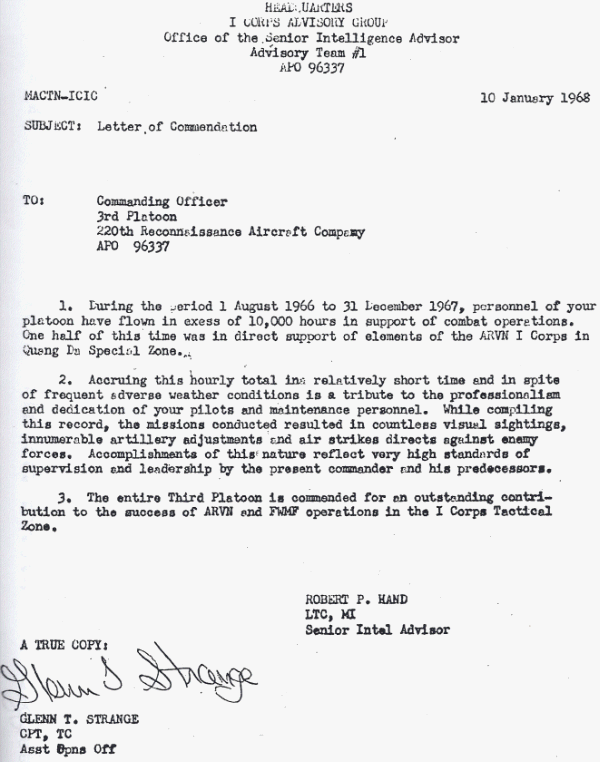

The second platoon leader for this period was MAJ Dick Tobiason:
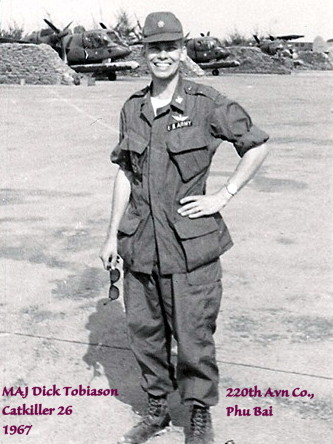
On 21 January the 1st Platoon lost CWO William Arthur Kimsey and CPT Charles James Ramsay, USMC AO, while on an artillery mission in the DMZ with both being reported as MIA. (Both of their remains were later recovered and returned home to their families.)
On 30 January seven of the 2nd Platoon aircraft were destroyed on the ground as the Hue / Citadel Airfield was over-run in the Tet ´68 attack on Hue City. By 2 February the entire Platoon was forced to evacuate Hue and move to Phu Bai. The infamous Tet Offensive by the NVA was underway. (Get Gary O´Shields to tell you about his wild ride with Harold Vail through the streets of Hue City during the excitement. Maybe Harold can add a few comments as well.)
As the Company revamped itself at Phu Bai with the additions of the 1st Platoon from Quang Ngai and now the addition of the 2nd Platoon at Hue, there obviously had to be some adjustment in the conduct of business as usual in the 220th. Due to the heavy loss of the 2nd Platoon aircraft there was a major reorganization of the platoons. At that time it also appears that the DMZ / Tally Ho mission was reassigned as a joint undertaking by both the 4th Platoon and the 1st Platoon as well as supporting the entire northern I Corps Tactical Zone in Quang Tri Province.
On 22 February 1LT Terrance M. Bozarth was KIA near Hue; his AO, 1LT Bob Laramy, 1st Marine Division, was rescued from the resultant crash and survived. [I talked with Bob on 1 Feb 2011.]
On 14 April MAJ Clark passed command of the Company to MAJ Millard L. Pedersen.
On 5 June there was another reorganization of the two platoons working in Quang Tri Province. Since both the 1st and 4th Platoons were working with the 3rd Marine Division and the 108th Field Artillery Group, the 4th Platoon assets were reallocated and absorbed into the 1st Platoon to simplify the administration and control of the overall support efforts in the DMZ and entire northern area of I Corps. (It appears that the 4th Platoon was "deactivated" temporarily and I am still trying to learn a bit more of how the 1st and 4th Platoons had previously worked together. I am hoping to talk with someone who can recall some detail of this. We will see the "return" of the 4th Platoon later.)
On 16 June support of Operation Prairie Fire with the 5th Special Forces Group took the 220th across Vietnam´s western border into Laos.
On 26 June a rocket attack on the billets area at Da Nang / Marble Mountain Air Facility took the life of SP5 James Houston Roulett (KIA) and wounded SFC Edgar L. Wells (the Plt Sgt?) and Specialist Joe H. Estes.
During 3-7 July the 220th combined assets [the "heavy" 1st Platoon ( + )] operating out of Dong Ha flew over 180 missions north of the DMZ resulting in nearly 250 hours of flying time north of the Ben Hai River. The efforts were in support of Operation Thor, a large counter-battery mission that was conducted by the 108th Field Artillery Group, directed against enemy artillery positions which posed a threat to friendly forces just south of the DMZ. The four day operation was so successful that Headquarters XXIV Corps extended it indefinitely (July until some time in November).
On 4 August elements of the 101st Airborne Division moved into the A Shau Valley for Operation Somerset Plain with the 220th to be operating in support on a 24 hour-a-day basis.
On 6 August MAJ Pedersen passed command of the Company to MAJ James M. Wisby, his Executive Officer.NOTE: I have some knowledge regarding the missioning of the 220th during Operation Somerset Plain; however, I am deferring any comment for discussion until I have been able to walk in the footprints of a few more veterans of the 220th of that time. We had started flying some 10,000-feet altitude night radio relay missions over the A Shau Valley in relief of the 18th Aviation "Otter" Company in support of Long Range Reconnaissance Patrols, as preparation got underway to go back into the A Shau in 1967. However, night single ship missions at low altitude for VR with a Starlight Scope in the A Shau Valley did not seem to be a good situation for the longevity and survivability of aircraft, pilot or the observer over the long, or short, haul. I also have an accounting of a mission that was flown by Jim Wisby, then the CO, which resulted in the cancellation of that particular VR mission, although I understand there were other night missions that were flown in support of this 101st Airborne Division Operation.We learned the sad news that MAJ William "Bill" O. Schmale, the original Executive Officer of the 220th and its second Commanding Officer, was KIA on 13 August while on his second tour in RVN as the Aviation Safety Officer with the 1st Aviation Battalion, 1st Infantry Division, Tay Ninh, Binh Long Province.
On 29 August OPCON of the 220th changed to the XXIV Corps as Army operations began to take control in the I Corps Tactical Zone.
On 15 September the 3rd Platoon moved from Da Nang / Marble Mountain to Phu Bai collecting all of the platoons at the company headquarters area. The 134th Medical Detachment and the 231st Signal Detachment (Avionics Repair) continued to support the 220th as attached units in Phu Bai.
We learned that CPT Benjamin "Ben" C. Hartman, another of the original Catkillers of the 220th, later Platoon Leader of the 3rd Platoon at Da Nang / Marble Mountain, was KIA on 19 September while a Helicopter Non-Crew member on his second tour in RVN with Headquarters, 17th Aviation Group, in Darlac Province.
On 25 September the battleship, USS New Jersey, stationed along the north shore of South Vietnam, fired its first mission into the DMZ—the first of many to be adjusted by 220th pilots and their USMC AOs.
Although Operation Rich, which took place in the DMZ during 23-27 October, is not mentioned in the Unit Historical File of Significant Events, the Battle of Kinh Mon was certainly significant for Bill Hooper, Charlie Finch and Rod Stewart in their support of the 1st Brigade, 5th Infantry Division Army Infantry and Armored units on the ground in that Operation. Read Chapter 7 of A HUNDRED FEET OVER HELL, "My People Need Help", and you will be provided a detailed accounting of the events of 25 October for those three pilots of the 1st Platoon out of Dong Ha which was not quite the "typical daily operations." All three Catkillers were later properly recognized by the award of the Silver Star for their extraordinary actions that day.
On 29 October 1LT Donald Lee Harrison and 1LT Steven Neil Bezold, 108th Artillery AO, were lost to enemy action in North Vietnam and are still carried as MIA.
Effective 1 November 1968 President Johnson´s directed Bombing Halt resulted in no more flying north of the DMZ.
During the year 23,383 sorties were flown by the four platoons and the company headquarters for a total of 25,995 hours in support of all operations in the I Corps Tactical Zone, the DMZ and North Vietnam.NOTE: If you have not read A HUNDRED FEET OVER HELL, by Jim Hooper, you can capture an up-close account of the activities of 220th pilots as they supported the 3rd Marine Division, the 108th Field Artillery Group and the 1st Brigade, 5th Infantry Division and other units in the northern I Corps Tactical Zone, the DMZ and Tally Ho during mid-1968 through mid-1969. The book tells the story much better than I could condense the challenges, experiences and performance of this particular group of "Catkillers" under fire in my purpose for writing this historical overview of the 220th Aviation Company. As we follow on into 1969, you may find the exploits of these O-1 Birddog pilots exciting, and at times, entertaining as well, as they lived from day to day, sometimes hour to hour, in the awing experience of war, meeting it head on, and also their individual and collective manners of temporary escape from it.
CATKILLER OFFICER’S CLUB INTRODUCED:
Needing a place to unwind, relax or just shed the stress of the day, a club facility was erected by many different hands and became operational during the early part of this year. Captain Raymond G. Caryl, Catkiller 32/42, captured this classic photo shot just as the facility came into daily use, which is followed by a statement from Ray:
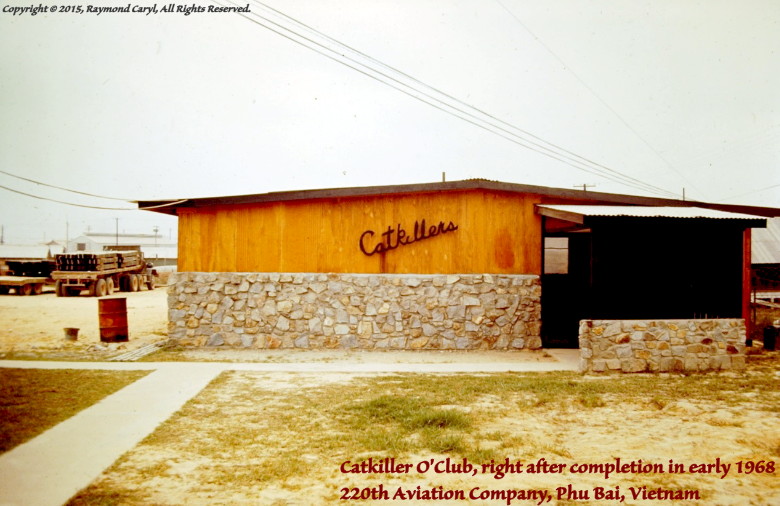
The stonework was accomplished mostly by the Aerial Observers. One of them (Bob Happe, I think) had experience as a stonemason, and he spearheaded that part. Of course our guys pitched in as well. Maybe John E., “Bear” Kovach, Don Pepe or Mike Sharkey can verify who the stonemason was. There is also a follow–on shot of the club available at the 1971 history overview, in which WO1 Patrick Snyder was captured walking on the precious grass.





